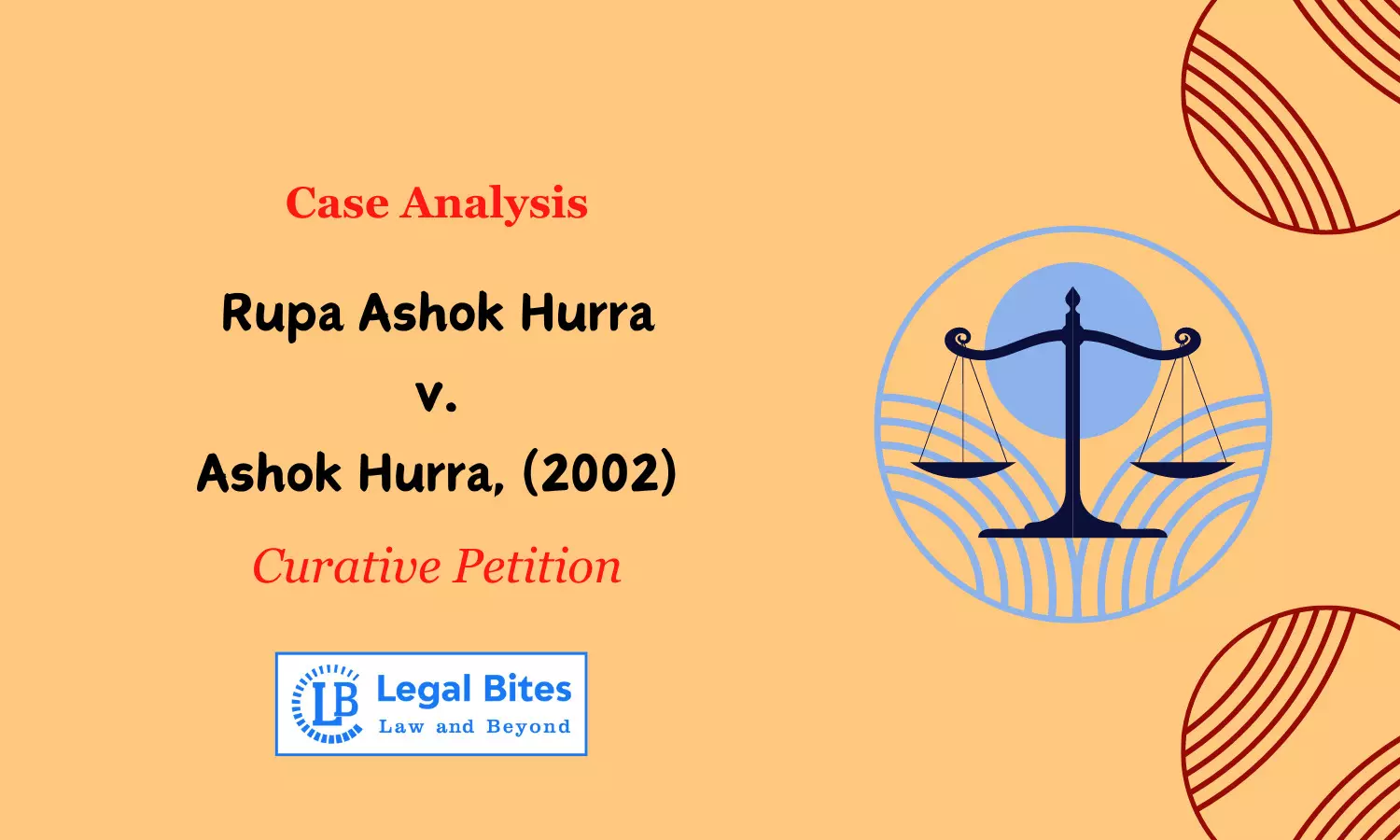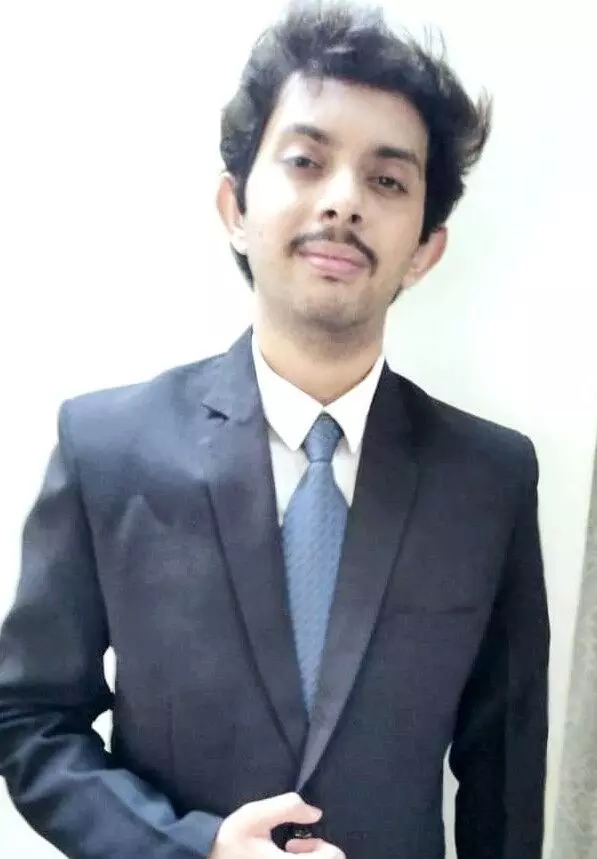Case Analysis: Rupa Ashok Hurra v. Ashok Hurra, AIR 2002 SC 177 | Judicial Review
This landmark case established a precedent for judicial scrutiny, affirming the judiciary's unwavering commitment to ensuring justice for all.

This landmark case established a precedent for judicial scrutiny, affirming the judiciary's unwavering commitment to ensuring justice for all.Case Title: Rupa Ashok Hurra v. Ashok HurraCourt: Supreme Court of IndiaCitation: AIR 2002 SC 177Judges: S.P. Bharucha CJI, S.S.M. Quadri (J), U.C. Banerjee (J), S.N. Variava (J) & S.V. Patil (J)FactsThe facts of the case involve a matrimonial discord between a husband and a wife who have already been separated from each other for years. Later,...
This landmark case established a precedent for judicial scrutiny, affirming the judiciary's unwavering commitment to ensuring justice for all.
Case Title: Rupa Ashok Hurra v. Ashok Hurra
Court: Supreme Court of India
Citation: AIR 2002 SC 177
Judges: S.P. Bharucha CJI, S.S.M. Quadri (J), U.C. Banerjee (J), S.N. Variava (J) & S.V. Patil (J)
Facts
The facts of the case involve a matrimonial discord between a husband and a wife who have already been separated from each other for years. Later, the woman withdrew her consent which was given through divorce with mutual consent, which resulted in the case going to the Supreme Court. Here, the validity of the decree of divorce was questioned by the parties. Various substantial questions and issues were raised relating to whether an aggrieved party would be entitled to seek any relief against the final judgment or the order of the Supreme Court, after dismissal of the Review Petition under Article 32 or otherwise.
Issue
- Whether an aggrieved person, after the dismissal of a review petition, possesses entitlement to relief against a final judgment either under Article 32 of the Constitution or through alternative means.
Laws Applied
- Article 19(1)(a), Article 137, Article 226, Article 32 & Article 142 of the Constitution of India
- Section 302 of I.P.C.
Arguments in Favour of the concept of Curative Petition
Dr. Rajiv Dhawan, learned Senior Counsel, argued that since the Supreme Court is a creation of the Constitution the corrective power has to be derived from the provisions conferring jurisdiction on the Supreme Court like Articles 32 and 129 to 140 itself.
Mr. Ranjit Kumar, learned Senior Counsel, advocated that in case of any manifest illegality and palpable injustice, the Supreme Court under its inherent powers could reconsider the final judgment or order passed by the Honourable Court. The reconsideration shall be done via the concept of a curative petition.
Furthermore, it was proposed that the composition of a Bench shall be tasked with considering the said curative petition. The bench may consist of senior judges, along with the judges who passed the original order, if possible. It was also proposed that while considering such curative petitions on the ground of manifest injustice, in the rarest of rare cases, the doctrine of stare decisis is also required to be kept in mind.
Therefore, although the principle of finality of the judgment of a Supreme Court is of great importance, rendering justice happens to be of no less importance. Hence, to prevent abuse of its process and to cure a gross miscarriage of justice, the Supreme Court Court may reconsider its judgment in the exercise of its powers under curative petitions.
Requirements Established for the Filing of Curative Petition
Although the judgments could be reviewed for a second time by the Supreme Court even after the dismissal of a petition under Article 32, it was essential to establish certain requirements for the reviewing of a judgment under a curative petition, so that floodgates are not opened for filing a second review as a matter of course in the guise of a curative petition. Hence, only those judgments would fall under the ambit of the curative petition, which met the requirements mentioned below:
Violation of Natural Justice
A petitioner is entitled to relief ex debito justitiae (done by the requirement of justice) if they establish a violation of principles of natural justice and where in the proceedings a learned judge fails to disclose his connection with the subject matter.
Relevance with Ashok Hura Case
The affidavit that may accompany the curative petition shall mention that the petition is governed by the judgment in the Ashok Hurra case. Also, It shall not contain any new grounds that have been taken.
Dismissed by Circulation
The petitioner in the curative petition shall also specify that the grounds mentioned had been taken in the Review Petition and that it was dismissed by circulation.
Certificate of Fulfillment of the Requirements
The curative petition shall contain a certificate by a senior advocate concerning the fulfilment of the requirements mentioned above.
Therefore, the concept of curative petition came into existence considering that it would be an extremely strong discretionary power and could be exercised only in rare cases. The Order XLVIII of the Supreme Court Rules, 1966 states that after the dismissal of a case in review under Article 137 of the Constitution, by way of circulation, a curative petition can be filed under the inherent jurisdiction of the Supreme Court to prevent abuse of its process and cure gross miscarriage of justice. Such was the law laid down in the Ashok Hurra case.
It can be both, a civil or a criminal petition. Such a petition is to be circulated to and heard by a bench of three senior judges as well as the judges who passed the judgment in question if they are available. If the Bench before which such a petition is circulated deems it as just and proper, it may list the same for hearing before the same Bench, as far as possible.
Contention of Parties
Petitioner’s Contention
Mrs. Rupa Ashok Hurra (Petitioner) said that the Supreme Court has the power to check its own decisions if there's a clear mistake on the record. This is important to fix any unfair decisions and make sure things are fair for everyone. She said that changing the agreement that she and the other party agreed on was a mistake. This mistake caused a lot of problems and changed what was originally agreed upon. So, she asked the court to correct this mistake and go back to the original agreement.
She also said that she had the right to change her mind about getting divorced because things had changed since they first agreed to it. She thought that her right to change her mind should be respected, especially since the divorce wasn't finalized yet. Mrs Hurra also said that changing the agreement affected her rights a lot because it was like a legal contract between her and the other person. Lastly, she talked about bigger concerns about the laws of the country. She questioned if it was fair for the court to change decisions, especially when it could have a big impact on people's rights and agreements. She worried that this might go against the fair and just rules written in the Constitution of India.
Defendant’s Contention
Mr. Ashok Hurra (Defendant) made several arguments in response, first, he said that when both parties agree on something and the court writes it down, it should be final and cannot be changed later by just one person. He thought that these written agreements, called consent decrees, were special and shouldn't be changed unless both parties agreed. He supported the court's decision to change the agreement, saying it was the right thing to do to make sure the case was fair. He believed that the court had the power to fix any mistakes in its decisions, and in this case, changing the agreement was necessary to fix a mistake.
Also, he disagreed with the idea that the Supreme Court shouldn't be able to review its own decisions, especially when it involves written agreements like consent decrees. He thought that reviewing decisions was important to fix any big mistakes and make sure justice was served. Lastly, he said that while he understood the concerns about the Constitution, he believed that the court's power to review decisions was fair and important for making sure things were just.
Overall, Mr Hurra's main argument was that the agreement made by both parties should be final, but he supported the court's decision to change it because it was needed to fix a mistake and ensure fairness. He also advocated for the court's authority to reevaluate its decisions when deemed necessary for the sake of justice.
Judgment
The Supreme Court in its decision agreed that it could check its own decisions under a curative petition if there were obvious mistakes. They said that the power to review decisions was really important, and it was following Article 137 of the Indian Constitution. Mrs Rupa Ashok Hurra said there was a big mistake in the decision, and the Court agreed. They said that changing the consent agreement was a mistake and caused unfairness.
They wanted to be clear that they weren't going back on the whole case, just fixing this one mistake. The Supreme Court explained that the review power wasn't for redoing cases but for fixing big mistakes that made the decision completely wrong. They thought that changing the consent agreement was one of those big mistakes. So, the Court said Mrs. Hurra was right, and they changed their earlier decision. They went back to the original agreement, making sure everything was fair and fixing the mistake without messing up other decisions or agreements.
Conclusion
It is important to understand that the legal system is an ever-evolving and ever-changing field. Judges, lawyers, and even courts, an entity as a whole are indeed capable of making mistakes. Now, when a lower court makes a mistake, there are ways to fix it, like reviewing the decision or filing an appeal. But when the Supreme Court makes a decision, it's supposed to be final. Now, because the Supreme Court's decisions are supposed to be the final word, they cannot just change its mind whenever it feels like it.
But then again, we have to remember that judges belonging to the Supreme Court are also humans, and humans are prone to making mistakes. That's why it became important to have a way for the Supreme Court to take a second look at its own decisions.
It's not about undermining their authority, rather, it's about ensuring that justice is truly served, even if it means admitting that mistakes were made along the way. In the case of Rupa Ashok Hurra v. Ashok Hurra, it was established that an Apex Court's decision can be reviewed for a second time too, even if a petition under Article 32 of the Indian Constitution for the same has been dismissed.
The review may occur under a curative petition, the condition being that the said curative petition meets all the requirements established, to avoid the abuse of this remedy. So, introducing the concept of curative petition made room for the Supreme Court to review its judgments, which is just another step in the quest to ensure that justice is done in every possible way, therefore, further solidifying the Indian legal system.

Husain Rizvi
Husain's exceptional skills as a content writer, coupled with his extensive knowledge of various law subjects, enable him to produce effective and impactful content. Institution: Rizvi College of Law, Mumbai.
